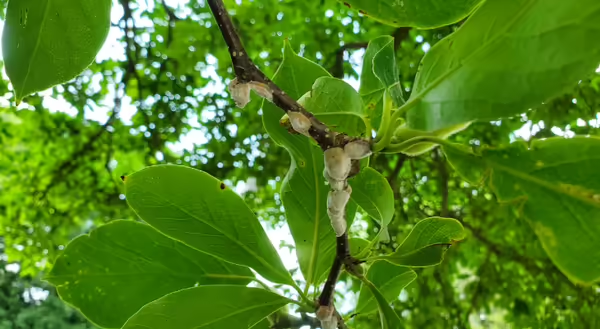
Magnolias are some of the most popular ornamental trees across the US. Known for spectacular flowering displays, they come in various shapes and sizes, from smaller shrub-sized plants to medium-sized shade trees.
For the most part, these trees are usually a pretty safe bet in Illinois gardens. They perform well in our climate, typically flower profusely year after year and tolerate a fair range of conditions.
Life cycle and identification
However, in recent years, I’ve noticed an uptick in reports of one of their main insect pests in Illinois. Magnolia scale (Neolecanium cornuparvum) affects nearly all magnolias. Non-native magnolias and hybrids tend to be more susceptible, but it has been noted on our native species as well.
Small infestations may not have much effect on tree health, but as populations build, this pest can seriously affect tree health and even lead to death. They feed on tree sap, so the more sap they consume, the less energy the magnolia tree has for its life processes.
Magnolia scale is a soft-scale insect, meaning that the covering or armor they develop as adults lacks the hard protective cover that hard-scale insects produce. Instead, they have a soft, almost fuzzy-like covering created from waxy secretions. It functions the same as hard-scale coverings in that it protects the insect from predation. However, this pest is often not recognized as a scale insect due to its fuzzy appearance.
Scale insects are unique in their apparent mobility in earlier life stages versus their sedentary lifestyle as adults. They are born in August and September as tiny, six-legged crawlers, which live up to their name as they crawl about twigs looking for a feeding site. Once they find the perfect spot, they settle down to overwinter.
In spring, the crawlers become active again, moving about to resume feeding. As spring progresses, they settle down in a single location where they will remain to mature into adults. Males eventually emerge as gnat-like insects to mate and then die. Females will turn white to brownish purple and begin producing their waxy coating, continuing to grow and enlarge until about this time of year.
Females give birth to crawlers during late summer and early fall, and the lifecycle continues. However, adult females die after giving birth. So, their population is perpetuated by overwintering crawlers.
Control methods
There are a variety of control options for magnolia scale, but an understanding of their life stages is required to time them effectively. The simplest control method for smaller populations on smaller trees is the manual removal of females in June and July as they settle down to feed and produce their protective cover. The insects can be scraped off the bark with your fingernail or a small scraping tool, taking care to minimize bark damage. You can find a demonstration for this strategy here.
For larger tree canopies, a significant number of adults can be sprayed off with a hose. Care must be taken not to break the bark, so don’t use your power washer, but most garden hose nozzles with a more concentrated setting can effectively remove scale insects. This method may need to be repeated for several years to knock their population down, but it remains one of the easiest and cheapest control options.
Crawlers can be controlled as they emerge in August or September with insecticidal soaps or horticultural oil. They can also be effectively controlled in early spring with horticultural oil applied before bud break. However, these methods are contact treatments requiring thorough coverage of all twigs and stems, which may require specialized spray equipment and may be best left to tree care professionals.
As a last resort, systemic insecticides can be injected into the tree several weeks before crawlers become active in spring. Timing varies based on spring weather, but typically, applications are made in April to ensure adequate uptake by the plant prior to spring crawler activity. This treatment is also probably best left to professionals.
Maintaining Tree Health
In many cases, scale infestations can be managed with mechanical removal if detected early enough. So, be sure to inspect magnolia trees regularly, especially this time of year, as the females mature and become easier to spot. Boosting tree health by mulching out to the dripline and watering during the hotter months is also an effective strategy for preventing and treating active infestations.